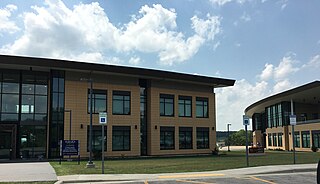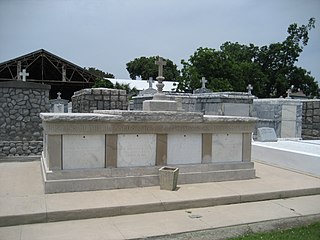Related Research Articles

Mackinac County is a county in the Upper Peninsula of the U.S. state of Michigan. As of the 2020 census, the population was 10,834. The county seat is St. Ignace. Formerly known as Michilimackinac County, in 1818 it was one of the first counties of the Michigan Territory, as it had long been a center of French and British colonial fur trading, a Catholic church and Protestant mission, and associated settlement.

The Bureau of Indian Affairs (BIA), also known as Indian Affairs (IA), is a United States federal agency within the Department of the Interior. It is responsible for implementing federal laws and policies related to Native Americans and Alaska Natives, and administering and managing over 55,700,000 acres (225,000 km2) of reservations held in trust by the U.S. federal government for indigenous tribes. It renders services to roughly 2 million indigenous Americans across 574 federally recognized tribes. The BIA is governed by a director and overseen by the Assistant Secretary for Indian Affairs, who answers to the Secretary of the Interior.

Irenaeus Frederic Baraga was a Slovenian Roman Catholic missionary to the United States and a grammarian by and author of Christian poetry and hymns in Native American languages. He became the first bishop of the Roman Catholic Diocese of Marquette, Michigan, originally sited at Sault Sainte Marie, which he led for 15 years.

The Osage Nation is a Midwestern American tribe of the Great Plains. The tribe developed in the Ohio and Mississippi river valleys around 700 B.C. along with other groups of its language family. They migrated west after the 17th century, settling near the confluence of the Missouri and Mississippi rivers, as a result of Iroquois expansion into the Ohio Country in the aftermath of the Beaver Wars.

John Augustus Tolton, baptized Augustine Tolton, was the first Catholic priest in the United States publicly known to be Black.

Saint Vincent Seminary is a Roman Catholic seminary in Latrobe, Pennsylvania. It was founded by Father Boniface Wimmer in 1846, who came from Saint Michael's Abbey in Metten, Bavaria, to establish Saint Vincent Archabbey as the first Benedictine monastery in North America. It is the fourth oldest Catholic seminary in the United States.
The Bureau of Catholic Indian Missions was a Roman Catholic institution created in 1874 by J. Roosevelt Bayley, Archbishop of Baltimore, for the protection and promotion of Catholic mission interests among Native Americans in the United States.

The National Black Catholic Congress (NBCC) is a Black Catholic advocacy group and quinquennial conference in the United States. It is a spiritual successor to Daniel Rudd's Colored Catholic Congress movement of the late 19th and early 20th century.
The Catholic Near East Welfare Association is a papal agency established in 1926 and dedicated to giving pastoral and humanitarian support to Northeast Africa, the Middle East, Eastern Europe, and India. CNEWA operates specifically in areas of concentrated mass poverty, war, and displacement, providing human dignity and addressing basic needs for vulnerable populations. As a Catholic organization CNEWA utilizes the network of Eastern Catholic Churches and devoted religious sisters to provide the most effective and holistic humanitarian support regardless of creed or religious affiliation. As sisters with CNEWA have stated, "We don't help people because they're Christian. We help [them] because we are."

The Sisters of the Blessed Sacrament (SBS) are a Catholic order of religious sisters in the United States. They were founded in 1891 by Katharine Drexel as the Sisters of the Blessed Sacrament for Indians and People of Color.

Charles Ewing was an attorney and Union Army general during the American Civil War. He was the son of Interior Secretary Thomas Ewing, the brother of Thomas Ewing Jr. and Hugh Boyle Ewing, and the foster brother and brother-in-law of William T. Sherman. Ewing's sister and Sherman's wife was Ellen Ewing Sherman.
From 1904 to 1991 the Marquette League served as a Roman Catholic fund-raising organization in the United States that supported Catholic missions and schools among Native Americans in the United States.

The Civilization Fund Act, also known as the Indian Civilization Act, was an Act passed by the United States Congress on March 3, 1819. The Act encouraged activities of benevolent societies in providing education for Native Americans and authorized an annuity to stimulate the "civilization process". Thomas L. McKenney lobbied Congress in support of the legislation. It was originally intended to support schools in native villages and areas, such as those established by religious missions. These were operated by both Protestant and Catholic organizations. In 1891 through the early 20th century, the government used the Civilization Fund Act as authority to establish numerous Native American boarding schools.
The Black and Indian Mission Office is a Catholic organization in the United States comprising the Bureau of Catholic Indian Missions, the Commission for the Catholic Missions among the Colored People and the Indians and the Catholic Negro-American Mission Board, which are institutions for mission work that maintain separate functions but operate with one staff and one board of directors.

The Pontifical Mission Societies (TPMS), known in some countries as Missio, is the name of a group of Catholic missionary societies that are under the jurisdiction of the Pope. These organizations include the Society for the Propagation of the Faith, the Society of St. Peter the Apostle, the Holy Childhood Association and the Missionary Union of Priests and Religious.
The Catholic Indian Missionary Association was a Roman Catholic fund-raising organization that supported Catholic schools and mission work among American Indians in the United States.
The Catholic Negro-American Mission Board is a U.S. Roman Catholic institution that raises funds and supports mission work in among African Americans.
The Tekakwitha Conference is a Roman Catholic institution that supports Christian ministry among Native Americans, primarily through its annual meeting.

James Theodore Augustus Holly was the first African-American bishop in the Protestant Episcopal church, and spent most of his episcopal career as missionary bishop of Haiti.

St. Francis Mission is a Roman Catholic mission complex on the Rosebud Indian Reservation in St. Francis, South Dakota, in territory of the Lakota (Sioux) Native Americans. The mission was founded in 1886 by priests of the Society of Jesus (Jesuits), who were welcomed by Bishop Martin Marty of the Diocese of Saint Cloud, Minnesota, which extended to this territory at the time. The Jesuit order soon developed a large complex to serve the Lakota at this reservation. Most of the buildings were destroyed by a fire in 1916, but many were soon rebuilt.
References
- ↑ Commission For The Catholic Missions Among The Colored People And The Indians (Black And Indian Mission Collection): Historical Note/Scope And Content. Marquette University. Retrieved June 17, 2010.
- ↑ Kevin Abing. "Monsignor Paul A. Lenz, 1976-2007" in Directors of the Bureau of Catholic Indian Missions, 1994. Marquette University. Retrieved June 17, 2010.